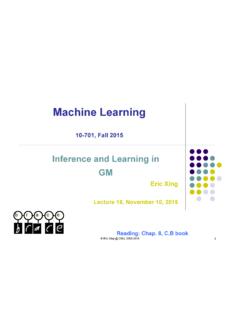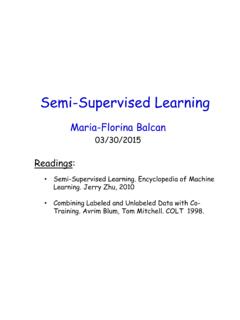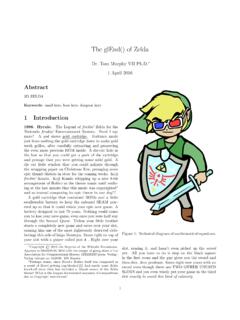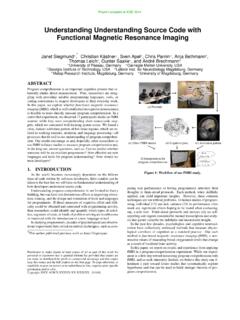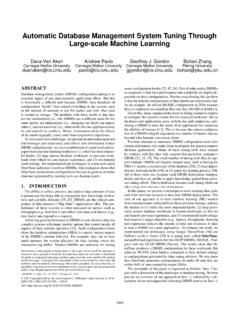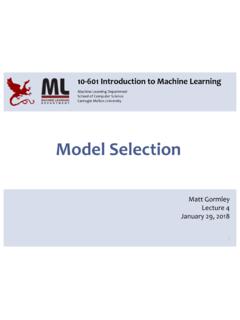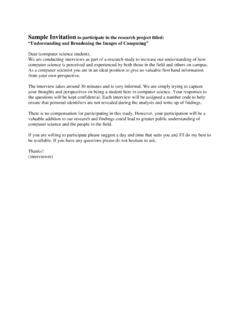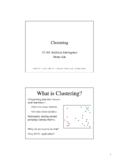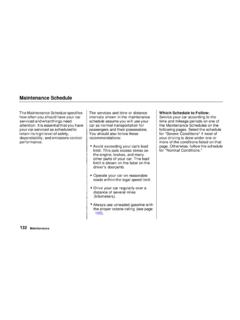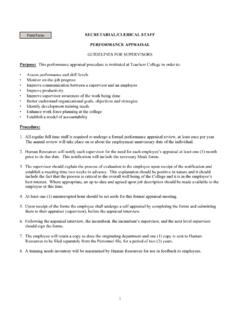Transcription of Software Testing Techniques - Carnegie Mellon School of ...
1 Software Testing Techniques Technology Maturation and Research Strategy Class Report for 17-939A Lu Luo Institute for Software Research International Carnegie Mellon University Pittsburgh, PA15232 USA 1 Software Testing Techniques Technology Maturation and Research Strategies Lu Luo School of Computer Science Carnegie Mellon University 1 Introduction1 Software Testing is as old as the hills in the history of digital computers. The Testing of Software is an important means of assessing the Software to determine its quality. Since Testing typically consumes 40~50% of development efforts, and consumes more effort for systems that require higher levels of reliability , it is a significant part of the Software engineering.
2 With the development of Fourth generation languages (4GL), which speeds up the implementation process, the proportion of time devoted to Testing increased. As the amount of maintenance and upgrade of existing systems grow, significant amount of Testing will also be needed to verify systems after changes are made [12]. Despite advances in formal methods and verification Techniques , a system still needs to be tested before it is used. Testing remains the truly effective means to assure the quality of a Software system of non-trivial complexity [13], as well as one of the most intricate and least understood areas in Software engineering [19].
3 Testing , an important research area within computer science is likely to become even more important in the future. This retrospective on a fifty-year of Software Testing technique research examines the maturation of the Software Testing technique research by tracing the major research results that have contributed to the growth of this area. It also assesses the change of research paradigms over time by tracing the types of research questions and strategies used at various stages. We employ the technology maturation model given by Redwine and Riddle [15] as the framework of our studies of how the Techniques of Software Testing first get the idea formulated, preliminarily used, developed, and then extended into a broader solution.
4 Shaw gives a very good framework of Software engineering research paradigms in [17], which classifies the research settings, research approaches, methods, and research validations that have been done by Software researchers. Shaw s model is used to evaluate the research strategies for Testing Techniques used in our paper. 2 The Taxonomy of Testing Techniques Software Testing is a very broad area, which involves many other technical and non-technical areas, such as specification, design and implementation, maintenance, process and management issues in Software engineering. Our study focuses on the state of the art in Testing Techniques , as well as the latest Techniques which representing the future direction of this area.
5 Before stepping into any detail of the maturation study of these Techniques , let us have a brief look at some technical concepts that are relative to our research. The Goal of Testing In different publications, the definition of Testing varies according to the purpose, process, and level of Testing described. Miller gives a good description of Testing in [13]: The general aim of Testing is to affirm the quality of Software systems by systematically exercising the Software in carefully controlled circumstances. Miller s description of Testing views most Software quality assurances activities as Testing . He contends that Testing should have the major intent of finding errors.
6 A good test is one that has a high probability of finding an as yet undiscovered error, and a successful test is one that uncovers an as yet undiscovered error. This general category of Software Testing activities can be further divided. For purposes of this paper, 1 Jointly written by Paul Li 2testing is the dynamic analysis of a piece of Software , requiring execution of the system to produce results, which are then compared to expected outputs. The Testing Spectrum Testing is involved in every stage of Software life cycle, but the Testing done at each level of Software development is different in nature and has different objectives.
7 Unit Testing is done at the lowest level. It tests the basic unit of Software , which is the smallest testable piece of Software , and is often called unit , module , or component interchangeably. Integration Testing is performed when two or more tested units are combined into a larger structure. The test is often done on both the interfaces between the components and the larger structure being constructed, if its quality property cannot be assessed from its components. System Testing tends to affirm the end-to-end quality of the entire system. System test is often based on the functional/requirement specification of the system.
8 Non-functional quality attributes, such as reliability , security, and maintainability, are also checked. Acceptance Testing is done when the completed system is handed over from the developers to the customers or users. The purpose of acceptance Testing is rather to give confidence that the system is working than to find errors. Static Analysis and Dynamic Analysis Based on whether the actual execution of Software under evaluation is needed or not, there are two major categories of quality assurance activities: Static Analysis focuses on the range of methods that are used to determine or estimate Software quality without reference to actual executions.
9 Techniques in this area include code inspection, program analysis, symbolic analysis, and model checking. Dynamic Analysis deals with specific methods for ascertaining and/or approximating Software quality through actual executions, , with real data and under real (or simulated) circumstances. Techniques in this area include synthesis of inputs, the use of structurally dictated Testing procedures, and the automation of Testing environment generation. Generally the static and dynamic methods are sometimes inseparable, but can almost always discussed separately. In this paper, we mean dynamic analysis when we say Testing , since most of the Testing activities (thus all the Techniques studied in this paper) require the execution of the Software .
10 Functional Technique and Structural Technique The information flow of Testing is shown in Figure 1. As we can see, Testing involves the configuration of proper inputs, execution of the Software over the input, and the analysis of the output. The Software Configuration includes requirements specification, design specification, source code, and so on. The Test Configuration includes test cases, test plan and procedures, and Testing tools. Based on the Testing information flow, a Testing technique specifies the strategy used in Testing to select input test cases and analyze test results. Different Techniques reveal different quality aspects of a Software system, and there are two major categories of Testing Techniques , functional and structural.
